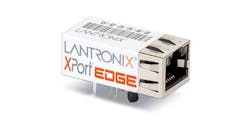For evidence as to how quickly the industrial technology market is gearing up to enable greater connectivity—for both new and legacy equipment—consider how little time has passed since my meeting with Lantronix last fall at the Internet of Things Solutions World Congress. At that meeting we discussed the company’s Mach10 Global Device Manager—a tool designed for OEMs and system integrators to provide secure web-scale device management for Industrial (IoT) devices. Since that last meeting, Lantronix has been putting the finishing touches on its newest tools for OEMs—its XPort Edge wired IoT gateway and its xPico 250 wireless gateway.
Previewing the XPort Edge at the Embedded World 2018 event in Nuremberg, Germany, Shahram Mehraban, vice president of marketing at Lantronix, says the device, which is “built on a high-performance real-time ARM-based system on a chip … is a complete IoT gateway with a robust network communications stack, enterprise-grade security and integrated cloud-based device management in the same patented form factor as the XPort.”
According to the company, the XPort Edge is “the first true wired IoT gateway in the industry in an easy-to-deploy RJ45 connector form factor.” Lantronix expects it to be available before the end of 2018.
Lantronix also announced the upcoming release of its xPico 250 embedded wireless gateway, which is designed to allow OEMs to add dual-band industrial Wi-Fi, dual-mode Bluetooth and Ethernet network connectivity with enterprise security into their industrial devices. Mehraban notes that, like Lantronix’s xPico 240, the xPico 250 comes pre-tested and pre-integrated with the company’s Mach10 Global Device Manager, Lantronix Gateway Central and TruPort Security including secure boot technology. The xPico 250 gateway is planned for release later in Q1 2018.
“XPort and the new XPort Edge are aimed at industrial machine makers and OEMs,” said Mehraban.“Most of these OEMs did not have network connectivity built into their legacy machines because those machines were never designed to be connected to a network. IoT gateways, such as Lantronix SGX5150, are used to provide network connectivity for these legacy devices by connecting the existing serial interface on these machines to an IP network—either wired or wirelessly.”
Though it is increasingly common for OEMs to integrate network connectivity into their machines, Mehraban contends that XPort devices are “the quickest and simplest way [for OEMs] to add network connectivity to an existing design. The machine maker doesn’t need to know anything about networking and [the XPort device] does not require [the OEM] to license a TCP/IP stack or write a line of code; they just have to lay the XPort module on their board, connect to the serial interface on their board, and they [can] have an Internet-ready next-generation machine.”
At the Embedded World event, Lantronix also demonstrated its new Lantronix Gateway Central Software as a Service (SaaS) powered by the Lantronix Mach10 IoT Platform. According to Mehraban, the Lantronix Gateway Central provides means to provision and manage Lantronix IoT gateways quickly and securely. Lantronix Gateway Central SaaS is available for both external and embedded IoT gateways, including PremierWave XC HSPA+, PremierWave 2050, SGX 5150, the new xPico 240 and xPico 250 embedded wireless gateways, and the XPort Edge.
Clarifying the difference between the Lantronix Gateway Central Software and the company’s Mach10 Global Device Manager, Mehraban says that Gateway Central Software is “a device management solution for Lantronix gateways—not OEM devices—and it is offered as a SaaS on a per-gateway pricing basis. The Mach10 Global Device Manager is targeted at OEMs to help them build multi-tenant device management capability for their own devices, as well as our gateways. Global Device Manager is a tool to help OEMs build a customized solution for their products.”
Leaders relevant to this article:


